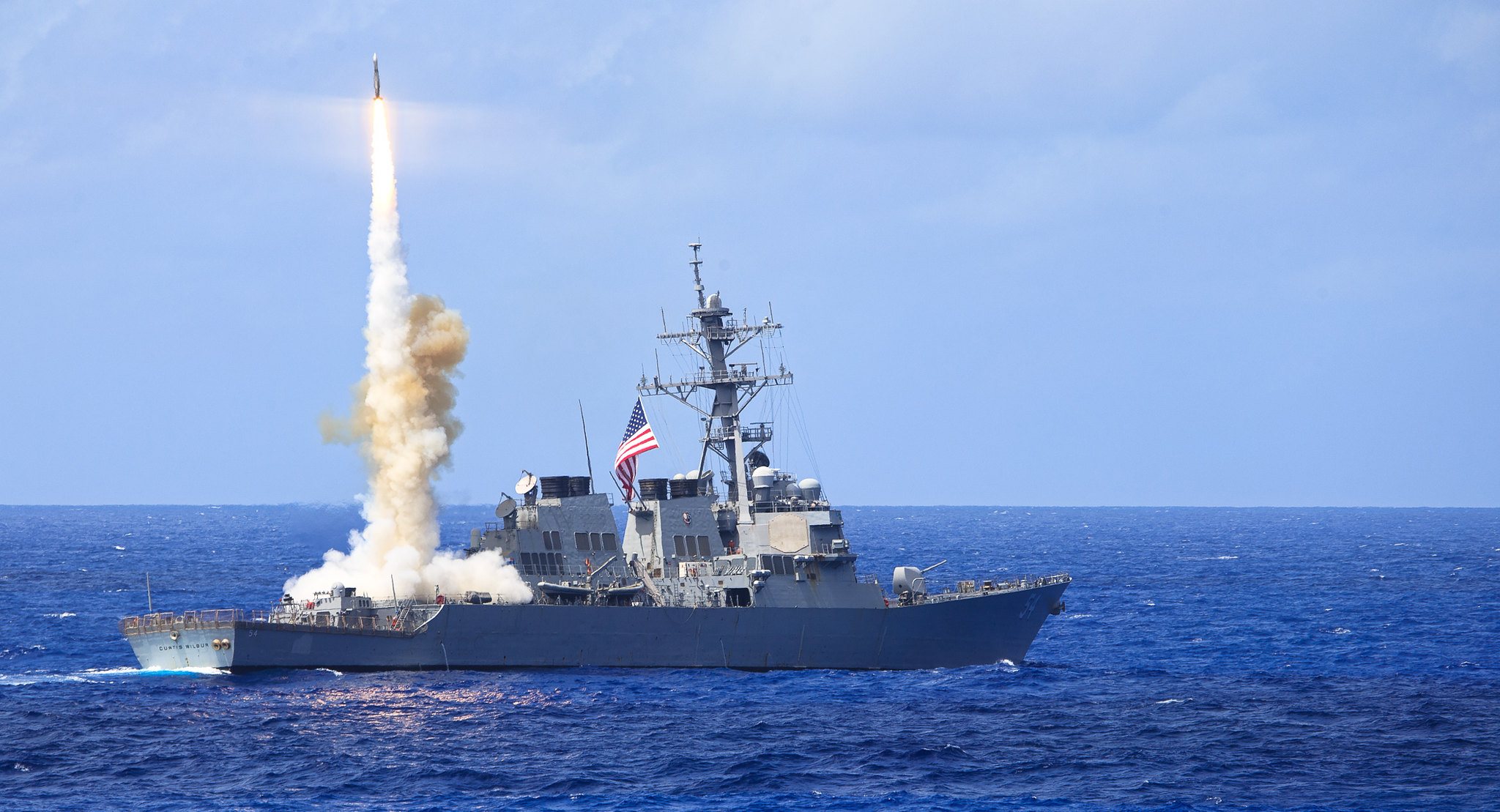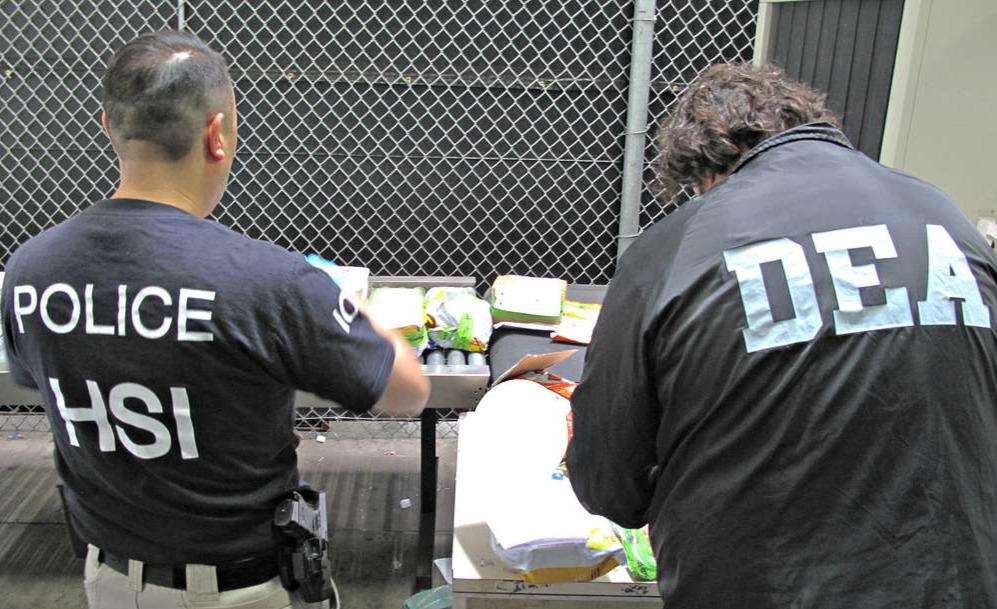The Middle East and the President’s Sweeping Power Over Self-Defense
Just about any conceivable use of force in the Middle East can be justified under an Article II self-defense theory. Which means that a lot rests on the president’s, and his subordinates’, prudence.

The Middle East may be on the verge of large-scale war, and the U.S. military is literally on the firing line. Late last week, the USS Carney intercepted and destroyed three missiles and several drones fired from Yemen even though it did not know where the missiles were headed. “We cannot say for certain what these missiles and drones were targeting, but they were launched heading north along the Red Sea potentially towards targets in Israel,” said Pentagon press secretary Brig. Gen. Pat Ryder. “This action was a demonstration of the integrated air and missile defense architecture that we built in the Middle East and that we are prepared to utilize whenever necessary to protect our partners and our interests,” he added.
The U.S. military presence in the Middle East is supported by a complex web of appropriations and statutory authorizations. But under what domestic legal authorization did the USS Carney use military force against missiles from Yemen without a known destination but possibly headed for Israel? I cannot find any statutory basis for this use of force. The answer is almost certainly the president’s power to exercise self-defense under Article II of the Constitution. What is happening right now in the Middle East—U.S. efforts to defend Israel and to deter a wider conflict—illustrates how all-encompassing, and consequential, this Article II self-defense power has become.
***
The president from the beginning has possessed the power, as Madison put it at the Convention, “to repel sudden attacks” on the nation. The Prize Cases confirmed amidst the Civil War that “[i]f a war be made by invasion of a foreign nation, the president is not only authorized but bound to resist force by force.”
This self-defense-at-home notion has expanded dramatically over the centuries to include various rationales that apply to self-defense abroad. I will list four, all of which are relevant to possible U.S. uses of force in the Middle East at the moment.
First, presidents have asserted, and courts have acknowledged, a unilateral presidential power to use military force to protect the lives and property of U.S. citizens abroad. As Attorney General Robert Jackson wrote in 1941, “the President's authority has long been recognized as extending to the dispatch of armed forces outside of the United States … for the purpose of protecting American lives or property or American interests.” Or as the Office of Legal Counsel explained in 1979 in connection with the Iran hostage crisis: “It is well established that the President has the constitutional power as Chief Executive and Commander-in-Chief to protect the lives and property of Americans abroad.”
Second, the executive branch has developed a robust conception of unit self-defense. The standing rules of engagement state that “[u]nit commanders always retain the inherent right and obligation to exercise unit self-defense in response to a hostile act or demonstrated hostile intent.” As the United States’ presence in the Middle East and Africa have grown, and as the ever-expanding U.S. presence draws threats and fire, the United States has increasingly relied on this form of self-defense as a basis for uses of force.
Third, as the unit self-defense directive makes clear (“demonstrated hostile intent”), the president’s power of self-defense includes anticipatory self-defense. The United States has construed anticipatory self-defense very broadly in international law discussions, and the executive branch clearly believes that Article II authorizes the president to protect the United States from anticipated attacks or to deter attacks, including abroad.
Fourth, the executive branch regularly asserts a concept of “collective self-defense” or “collective self-defense of Coalition partnered forces.” (The government appears recently to have begun to call this notion “ancillary self-defense,” perhaps to distinguish it from the international law “collective self-defense” theory.) The idea here is that the United States can use force in defending the partners it is protecting, or with which it is fighting. (The executive branch has also claimed that the national interest of “assisting an ally or strategic partner at its request” can justify a unilateral presidential use of military force. The “national interest” test is as capacious as the self-defense theory, perhaps more so, and there are points of overlap; but I analyze here the self-defense theory because this is the language in which the U.S. government has been discussing possible uses of force.)
The closest I have seen to an explanation from the executive branch on the scope of this collective self-defense power comes from a letter in which Sen. Tim Kaine (D-Va.) comments on the issue, which quotes a Defense Department response to his queries “whether collective self-defense could be invoked to support foreign partner forces engaged in hostilities against enemies that are not covered by a congressional authorization for use of military force (AUMF).” Here is Kaine’s account of the department’s response:
The Department’s reply stated that “collective self-defense in this context means extension of U.S. unit self-defense to foreign or irregular partner forces or persons.” Further that, “The collective self-defense supplemental rule of engagement, when approved, permits U.S. forces to defend partner forces from attack or an imminent threat of attack with necessary and appropriate force, and typically the authority applies irrespective of the group or individual committing the hostile act, or demonstrating hostile intent…Self-defense is not a deliberate, offensive use of force. Rather it is a reaction to an attack or imminent threat of attack. As such, collective self-defense is not typically limited to particular groups or individuals committing the hostile act or demonstrating hostile intent, including not being limited to groups covered by the 2001 AUMF or other congressional authorizations for the use of force. For example, U.S. forces responded in collective self-defense when Syrian pro-regime forces attacked a Syrian Democratic Forces base in Syria on February 7, 2018. In other tactical scenarios (as was the case in Niger on October 4, 2017), U.S. and partner forces on the ground are not obligated to identify whether the attackers are part of a particular group.”
I agree with Senator Kaine that the Defense Department here appears to believe “that, by merely designating a group as a partner force, it can respond with military action to protect that partner force and its property if threatened by any group—even one that poses no direct threat to the United States, its Armed Forces or persons, nor is covered by an AUMF.”
***
The executive branch has acknowledged one important relevant limitation on unilateral presidential uses of force: If the “anticipated nature, scope, and duration of the planned military operations, analyzed in light of the applicable historical precedent,” (internal quotations cleaned up) amount to “war,” the president must secure prior congressional approval. The executive branch has stated that “[t]his standard generally will be satisfied only by prolonged and substantial military engagements, typically involving exposure of U.S. military personnel to significant risk over a substantial period,” and that “military operations that do not include the introduction of ground troops are less likely to constitute a ‘war’” that requires congressional authorization.
Government lawyers have explained that the “anticipated nature, scope, and duration” test requires a “fact-specific assessment.” This is an understatement. Moreover, it is unclear whether, when, or how this limiting principle applies when the executive branch is exercising the president’s self-defense powers. If the exercise of self-defense is not in any real sense “planned”—if the force against which one must exercise self-defense is incoming—the second- and third-order consequences of self-defensive action are likely impossible to calculate or discern, and thus irrelevant. If the exercise of self-defense permits advanced deliberation—for example, in deciding how robustly to exercise partner self-defense to protect Israel—the “anticipated nature, scope, and duration” test can come into play. The heavily redacted OLC Soleimani opinion, it’s important to note, suggested that the test is not relevant, even with the possibility of deliberation, when the United States is defending itself, as opposed to a third party; and it applied the test in that instance precisely because the president sought to “advance national interests apart from the defense of U.S. persons.” Even if the “anticipated nature” test applies, “the fact that there is some risk to American personnel or some risk of escalation does not itself mean that the operation amounts to a war.”
The “anticipated nature” test would not stand in the way of the United States defending itself from attacks from Iran or Iranian proxy forces. And I seriously doubt it would stand in the way if the U.S. government otherwise wanted to defend Israel from attack using force from the air, without the introduction of ground troops, even though a larger war would be foreseeable. Certainly one could see how the government could reach this latter conclusion based on its published legal analyses of presidential war powers. But as noted above, the matter is fact intensive (and we do not know the facts, including how the United States would use force); and the fact-intensive answer is ultimately a matter of the commander’s, or the commander-in-chief’s, judgment. As Justice Jackson noted in a different but not entirely unrelated context, the answer likely depends “on the imperatives of events and contemporary imponderables, rather than on abstract theories of law.” As a practical matter, of course, a large-scale self-defensive response “cannot be sustained over time without the acquiescence, indeed the approval, of Congress, for it is Congress that must appropriate the money to fight a war or a police action.” But as had been clear since President Polk arranged the initiation of the Mexican-American War, a president’s self-defensive actions can leave Congress with practically no choice but to approve continuation.
***
So on the executive branch view, which is the only view that practically matters in this context, the president can exercise his Article II power (a) to protect U.S. lives and property abroad, (b) in unit self-defense, (c) in anticipatory self-defense, and (d) in collective self-defense of partnered forces. The only potential legal constraint here—about the anticipated intensity of the conflict and the subsequent potential exposure of U.S. troops to harm’s way—will not be relevant when there is no time for deliberation. It is potentially relevant when there is time to deliberate and defense goes beyond protecting U.S. troops or persons, but even there, the restraint will, I believe, ultimately be folded into and resolved by the overall assessment of the necessity and desirability of the U.S. defensive action.
Protecting U.S. lives or collective self-defense, or both, were likely at the basis of the missile shoot-downs by the USS Carney. Secretary of Defense Lloyd Austin yesterday highlighted the relevance of unit self-defense and defense of U.S. citizens more broadly when he noted the “prospect of a significant escalation of attacks on our troops and our people throughout the [Middle East] region” and then added that the United States has “a right to defend” itself. Worries about such escalation, and the possible need to exercise self-defense, were the premises of Austin’s announcement Saturday that he was sending “the USS Dwight D. Eisenhower Carrier Strike Group to the Central Command area of responsibility,” activating new missile defense systems in the region, and placing additional “forces on prepare to deploy orders as part of prudent contingency planning.”
The bottom line is this: Just about any conceivable circumstance in which the president (or his relevant subordinates) would think it prudent to use force in the Middle East can be justified under an Article II self-defense theory. Which means that a lot rests on the president’s, and his subordinates’, prudence.



.jpg?sfvrsn=cbb26fe8_9)

